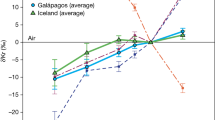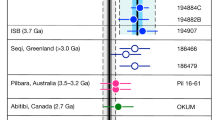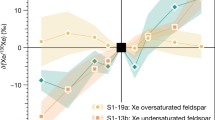Abstract
There has been much recent interest in the rare gas abundances of terrestrial materials, due mainly to the discovery of ‘excess’ radiogenic Ar and He trapped in deep-sea glasses1–4. The abundances of these gases indicated that such materials might effectively trap the internal Earth's atmosphere, and evidence of trapped primordial gases has by now been found not only in deep-sea glasses5–10, but also in xenolithic inclusions11–15, deep ocean waters16, CO2 well gas17–19, volcanic gas20 and diamonds21. The rare gas elemental abundances measured in these samples may not quantitatively reflect the deep-Earth pattern. Several elemental fractionation processes have been suggested, ranging from selective enrichment of the lighter gases in an upward-rising magma22,23 to posteruptive diffusion loss which would selectively deplete the lighter gases24. Each of these processes will affect concentrations of the helium and xenon isotopes in a characteristic manner, thus leaving in the glasses an isotopic fingerprint of what has occurred. New data are reported here which indicate extremely small concentrations of fissiogenic xenon in deep-sea basalts containing large concentrations of trapped excess radiogenic helium and argon. The resulting high 4Her/136Xef ratios are diagnostic of frac-tionation during the magmatic processes leading to eruption rather than of posteruptive loss of gas (which would show the opposite effect). The results indicate that studies of volatiles in general and of the rare gases in particular in such mantle-derived samples, even in those with no subsequent alteration or contamination, may be profoundly influenced by mass-dependent pre-eruptive effects. The consequences of this fractionation for the deep-Earth K/U ratio are discussed.
This is a preview of subscription content, access via your institution
Access options
Subscribe to this journal
Receive 51 print issues and online access
$199.00 per year
only $3.90 per issue
Buy this article
- Purchase on Springer Link
- Instant access to full article PDF
Prices may be subject to local taxes which are calculated during checkout
Similar content being viewed by others
References
Funkhouser, J. G., Fisher, D. E. & Bonatti, E. Earth planet. Sci. Lett. 5, 95–100 (1968).
Noble, C. S. & Naughton, J. J. Science 162, 265–267 (1968).
Dalrymple, G. B. & Moore, J. G. Science 161, 1132–1135 (1972).
Fisher, D. E. Earth planet. Sci. Lett. 14, 255–258 (1972).
Dymond, J. & Hogan, L. Earth planet. Sci. Lett. 20, 131 (1973).
Fisher, D. E. Nature 244, 344 (1973).
Fisher, D. E. Geophys. Res. Lett. 1, 161 (1974).
Lupton, J. E. & Craig, H. Earth planet. Sci. Lett. 26, 133–139 (1975).
Tolstikhin, I. N., Mamyrin, B. A., Khabarin, L. B. & Erlikh, E. N. Earth planet. Sci. Lett. 22, 75–84 (1974).
Craig, H. & Lupton, J. E. Earth planet. Sci. Lett. 31, 369–385 (1976).
Hennecke, E. W. & Manuel, O. K. Science 164, 1334–1336 (1971).
Hennecke, E. W. & Manuel, O. K. Nature 257, 778–780 (1975).
Kaneoka, I. & Takaoka, N. Earth planet. Sci. Lett. 39, 382 (1978).
Saito, K., Basu, A. R. & Alexander, E. C. Jr Earth planet. Sci. Lett. 39, 274–280 (1978).
Kaneoka, I., Takaoka, N. & Aoki, K. in Terrestrial Rare Gases (eds Alexander, E. C. Jr & Ozima, M.) 71–83 (Cent. Acad. Publ. Japan, Tokyo, 1978).
Clarke, W. B., Beg, M. A. & Craig, H. Earth planet. Sci. Lett. 6, 213–220 (1969).
Butler, W. A., Jeffrey, P. M., Reynolds, J. H. & Wasserburg, G. J. J. geophys. Res. 68, 3283 (1963).
Boulos, M. S. & Manuel, O. K. Science 174, 1334 (1971).
Boulos, M. S. & Manuel, O. K. Nature phys. Sci. 235, 150 (1972).
Craig, H., Lupton, J .E. & Horibe, Y. Adv. Earth planet. Sci. 3, 3–16 (1978).
Takaoka, N. & Oxima, M. in Terrestrial Rare Gases (eds Alexander, E. C. Jr & Ozima, M.) 65–70 (Cent. Acad. Publ. Japan, Tokyo, 1978).
Alexander, E. C. Jr, Nature 261, 77 (1976).
Ozima, M. & Alexander, E. C. Jr Rev. Geophys. Space Phys. 14, 385–390 (1977).
Fisher, D. E. Nature 256, 113–114 (1975).
Schwartzman, D. W. in Terrestrial Rare Gases (eds Alexander, E. C. Jr & Ozima, M.) 71–83 (Cent. Acad. Publ. Japan, Tokyo, 1978).
Fisher, D. E. Geochim. cosmochim. Acta 43, 709–716 (1979).
Author information
Authors and Affiliations
Rights and permissions
About this article
Cite this article
Fisher, D. Helium and xenon in deep-sea basalts as a measure of magmatic differentiation. Nature 282, 825–827 (1979). https://doi.org/10.1038/282825a0
Received:
Accepted:
Issue Date:
DOI: https://doi.org/10.1038/282825a0
This article is cited by
-
He, Pb, Sr and Nd isotope constraints on magma genesis and mantle heterogeneity beneath young Pacific seamounts
Contributions to Mineralogy and Petrology (1988)
-
Noble gases from oceanic island basalts do not require an undepleted mantle source
Nature (1985)
-
Rare gases from the undepleted mantle?
Nature (1983)
-
Quantitative retention of magmatic argon in a glassy basalt
Nature (1981)
Comments
By submitting a comment you agree to abide by our Terms and Community Guidelines. If you find something abusive or that does not comply with our terms or guidelines please flag it as inappropriate.



